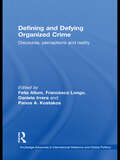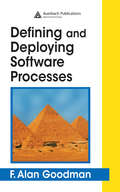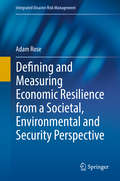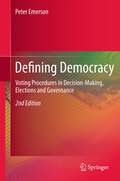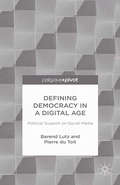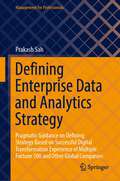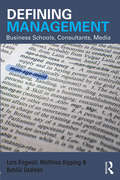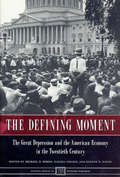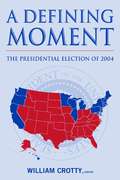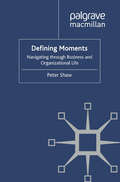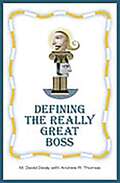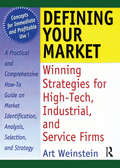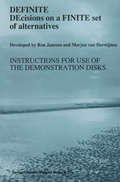- Table View
- List View
Deficits, Debt, and American Politics: Paper Shackles
by Marc Allen Eisner"For most of the history of the United States, periods of growing indebtedness—a product of wars and economic crises—were followed by reductions in the debt-to-GDP ratio." But why have the last several decades failed to follow this pattern, leaving the national debt at its highest level since World War II? In this groundbreaking new book, author Marc Allen Eisner, who has devoted most of his scholarly career to studying the evolution of the US political economy, explores the significant changes in the fiscal conditions of the United States during the postwar period, embedding the discussion in a broader historical context. He demonstrates that the national debt is in part a product of reduced revenues and the growing costs of the largest entitlement programs, but it also reflects a long series of shocks, including two wars, the financial crisis and Great Recession, and the COVID-19 pandemic. Deficits, Debt, and American Politics chronicles the history of the US debt in the postwar period, placed in the context of broader changes in the political economy and partisan politics. But it grounds this exploration in reader-friendly, chapter-length discussions of public finance, taxation, mandatory spending, and the budgetary process from a policy perspective. The volume concludes with a discussion of the challenges of comprehensive tax and program reforms in the current political climate.Deficits, Debt, and American Politics assumes little prior knowledge on the part of the reader, making it an ideal book for courses on public policy and political economy taught at both the upper-level undergraduate and graduate level. The material on public finance, long-term trends in taxation and spending, and the budgetary process, often relegated to descriptive texts, will be invaluable in courses engaging the deficit and debt.
Deficits, Debt, and American Politics: Paper Shackles
by Marc Allen Eisner"For most of the history of the United States, periods of growing indebtedness—a product of wars and economic crises—were followed by reductions in the debt-to-GDP ratio." But why have the last several decades failed to follow this pattern, leaving the national debt at its highest level since World War II? In this groundbreaking new book, author Marc Allen Eisner, who has devoted most of his scholarly career to studying the evolution of the US political economy, explores the significant changes in the fiscal conditions of the United States during the postwar period, embedding the discussion in a broader historical context. He demonstrates that the national debt is in part a product of reduced revenues and the growing costs of the largest entitlement programs, but it also reflects a long series of shocks, including two wars, the financial crisis and Great Recession, and the COVID-19 pandemic. Deficits, Debt, and American Politics chronicles the history of the US debt in the postwar period, placed in the context of broader changes in the political economy and partisan politics. But it grounds this exploration in reader-friendly, chapter-length discussions of public finance, taxation, mandatory spending, and the budgetary process from a policy perspective. The volume concludes with a discussion of the challenges of comprehensive tax and program reforms in the current political climate.Deficits, Debt, and American Politics assumes little prior knowledge on the part of the reader, making it an ideal book for courses on public policy and political economy taught at both the upper-level undergraduate and graduate level. The material on public finance, long-term trends in taxation and spending, and the budgetary process, often relegated to descriptive texts, will be invaluable in courses engaging the deficit and debt.
Defined Benefit Pension Schemes in the UK: Asset and Liability Management
by Philippe-N. MarcaillouThe goal of Asset-Liability Management (ALM) of a Defined Benefit Pension Scheme (DB) is to properly manage the risks related to variation in its building blocks on both sides of the balance sheet whilst maintaining the same expected return. This book provides a step-by-step methodology to maximize the complete restructuring and monitoring of the ALM of DB schemes. It is a product of the author's 25 years of experience and technical knowledge in ALM of Pension Funds, portfolio management, investment banking and, specifically, more than 700 meetings with investment experts in the Pension Industry. It includes 400 figures and tables to help the reader make appropriate decisions and identify hidden tricks. It provides an in-depth understanding of how an Asset-Liability structure works, how to assess the efficiency of an investment strategy, and how to maximize the management of cash. Liabilities and Liability Driven Investment techniques (LDI) are explained through numerous examples. The book shows the reader how to select the right LDI manager, and how to define a liability hedging strategy and monitor its efficiency. It demonstrates how to build efficient investment portfolios and select the appropriate asset classes, as well as how to build and monitor an efficient risks and performances report. In addition, it shows how the most common financial instruments work, their roles, the basics of statistics, and the principles of portfolio construction. Finally, it provides introduction to Buy-in, Buyout, and Longevity risk management.
Defining Aerospace Policy: Essays in Honor of Francis T. Hoban
by Julianne Lammersen-BaumFeaturing contributions from many of the most prominent contemporary figures in the US aerospace community, this book provides unprecedented insights into the ways in which aerospace policy is developed and implemented. Based on a wide range of real-life case studies and the personal experiences of those directly involved, its coverage includes some of the most influential and wide-ranging policies of modern times, including: the privatization of the Canadian air navigation system; government-industry cooperation; Leasecraft; NASA and the evolution of the hush kit; US activities to reduce launch costs; the emergence of a spaceport policy; VentureStar; issues in institutional restructuring: the problem with the FAA. Contributed in memory of Frank Hoban, the book compiles the work of a NASA funded team at George Mason University working on various institutional aspects of the aerospace policy and the aerospace industry, and also seeking out new directions for using the insights gathered from the NASA and other programs. The readership will include the management of aerospace companies and government agencies, especially in North America but also elsewhere, eg Europe (ESA), Russia and Japan. It will also include researchers and graduate students in university departments and agencies and other facilities.
Defining Aerospace Policy: Essays in Honor of Francis T. Hoban
by Julianne Lammersen-BaumFeaturing contributions from many of the most prominent contemporary figures in the US aerospace community, this book provides unprecedented insights into the ways in which aerospace policy is developed and implemented. Based on a wide range of real-life case studies and the personal experiences of those directly involved, its coverage includes some of the most influential and wide-ranging policies of modern times, including: the privatization of the Canadian air navigation system; government-industry cooperation; Leasecraft; NASA and the evolution of the hush kit; US activities to reduce launch costs; the emergence of a spaceport policy; VentureStar; issues in institutional restructuring: the problem with the FAA. Contributed in memory of Frank Hoban, the book compiles the work of a NASA funded team at George Mason University working on various institutional aspects of the aerospace policy and the aerospace industry, and also seeking out new directions for using the insights gathered from the NASA and other programs. The readership will include the management of aerospace companies and government agencies, especially in North America but also elsewhere, eg Europe (ESA), Russia and Japan. It will also include researchers and graduate students in university departments and agencies and other facilities.
Defining and Defying Organised Crime: Discourse, Perceptions and Reality (Routledge Advances in International Relations and Global Politics)
by Felia AllumOrganized crime is now a major threat to all industrial and non-industrial countries. Using an inter-disciplinary and comparative approach this book examines the nature of this threat. By analysing the existing, official institutional discourse on organized crime it examines whether or not it has an impact on perceptions of the threat and on the reality of organized crime. The book first part of the book explores both the paradigm and the rationale of policy output in the fight against organized crime, and also exposes the often ‘hidden’ internal assumptions embedded in policy making. The second part examines the perceptions of organized crime as expressed by various actors, for example, the general public in the Balkans and in Japan, the criminal justice system in USA and circles within the international scientific community. Finally, the third part provides an overall investigation into the realities of organized crime with chapters that survey its empirical manifestations in various parts of the world. This book will be of interest to students and scholars of international relations, criminology, security studies and practitioners.
Defining and Defying Organised Crime: Discourse, Perceptions and Reality (Routledge Advances in International Relations and Global Politics)
by Felia Allum Francesca Longo Daniela Irrera Panos A. KostakosOrganized crime is now a major threat to all industrial and non-industrial countries. Using an inter-disciplinary and comparative approach this book examines the nature of this threat. By analysing the existing, official institutional discourse on organized crime it examines whether or not it has an impact on perceptions of the threat and on the reality of organized crime. The book first part of the book explores both the paradigm and the rationale of policy output in the fight against organized crime, and also exposes the often ‘hidden’ internal assumptions embedded in policy making. The second part examines the perceptions of organized crime as expressed by various actors, for example, the general public in the Balkans and in Japan, the criminal justice system in USA and circles within the international scientific community. Finally, the third part provides an overall investigation into the realities of organized crime with chapters that survey its empirical manifestations in various parts of the world. This book will be of interest to students and scholars of international relations, criminology, security studies and practitioners.
Defining and Deploying Software Processes
by F. Alan GoodmanDefining and Deploying Software Processes enables you to create efficient and effective processes that let you better manage project schedules and software quality. The author's organized approach details how to deploy processes into your company's culture that are enthusiastically embraced by employees, and explains how to implement a Web-based pr
Defining and Measuring Economic Resilience from a Societal, Environmental and Security Perspective (Integrated Disaster Risk Management)
by Adam RoseThis volume presents an economic framework for the analysis of resilience in relation to societal, environmental, and personal security perspectives. It offers a rigorous definition of economic resilience and an operational metric, and it shows how they can be applied to measuring and applying the concept to private and public decision making. Major dimensions of resilience and their implications for human development are explored. Resilience is emphasized as a coping mechanism for dealing with short-term crises, such as natural disasters and acts of terrorism. As well, the author shows how lessons learned in the short-run out of necessity and through the application of human ingenuity can be incorporated into long-run sustainability practices. In part, this opportunity stems from viewing resilience as a process, one that enhances individual and societal competencies. The book links economic resilience to several other disciplines and examines the relationship between resilience and various other key concepts such as vulnerability, adaptation, and sustainability. It scrutinizes the measurement of economic resilience in terms of temporal, spatial, and scale dimensions. It examines the time-path of resilience and relates it to the recovery process.This work also looks closely at progress on the formulation of resilience indices and stresses the importance of actionable variables. It presents a risk-management framework, including aspects of cost-effectiveness and cost-benefit analysis. Additionally, it explores the role of resilience in relation to the co-benefits of disaster risk management.
Defining and Protecting Autonomous Work: A Multidisciplinary Approach
by Tindara Addabbo Edoardo Ales Ylenia Curzi Tommaso Fabbri Olga Rymkevich Iacopo SenatoriThis book, adopting a multidisciplinary approach, investigates the definition of autonomous work and the kind of protection it receives and should receive in a global perspective. The book advocates for the existence of genuine autonomous work to be distinguished from employment and false self-employment. It deserves specific attention from legislators in the view of removing any obstacles to the exercise of freedom of association and collective action at large. The book is divided into two parts. The first focuses on the evolving notion of autonomy and its consequences on social protection, offering a theoretical frame from an organizational, political and legal point of view. The second aims at discovering new regulatory and protective horizons for autonomous work, in the light of blockchain, platform work, EU Competition Law, social security and liberal professions. Finally, the authors offer insights and recommendations on how to protect work beyond categories.
Defining Democracy: Voting Procedures in Decision-Making, Elections and Governance
by Peter EmersonDefining Democracy looks both at the theory of why and the history of how different voting procedures have come to be used – or not, as the case may be – in the three fields of democratic structures: firstly, in decision-making, both in society at large and in the elected chamber; secondly, in elections to and within those chambers; and thirdly, in the various forms of governance, from no-party to multi-party and all-party, which have emerged as a result.
Defining Democracy in a Digital Age: Political Support on Social Media
by B. Lutz P. ToitThe internet has created a new social base where governments are ever more critically examined and measuring public sentiment expressed on social media is crucial to gauging ongoing support for democracy. This book illustrates a methodology for doing so, and considers the impact of this new public sphere on the future of democracy.
Defining Enterprise Data and Analytics Strategy: Pragmatic Guidance on Defining Strategy Based on Successful Digital Transformation Experience of Multiple Fortune 500 and Other Global Companies (Management for Professionals)
by Prakash SahThis is the first of its kind book that describes key elements of enterprise data and analytics strategy, and prescribes a pragmatic approach to define the strategy for large enterprises. The book is based on successful digital transformation experience of multiple Fortune 500 and other large enterprises. It is estimated that more than 50% of data and analytics initiatives fail globally because of the inherent complexity of such initiatives. Some of the questions that enterprises struggle with are: How to define enterprise data and analytics strategy? What are the key elements that should be considered while doing so? Why one-size-fits-all approach does not work for all enterprises? How to align data and analytics initiative with the business strategy of the CEO? How to establish a futuristic technology and architecture foundation, given the exponential rate of innovation in data and analytics technologies? How to define the right data and analytics organization model? Why data and analytics organization and processes need to be different from other functions? How to manage organizational change to ensure success of data and analytics initiative? How to define a business value measurement framework and calculate ROI from data and analytics initiative? What are the key skills required in a data and analytics leader to wade through political and other challenges of a large enterprise? This book will help executives, chief digital/analytics officers, data and analytics professionals, and consultants, in answering the above questions. It will help them in addressing various dilemmas that they face every day and making their enterprises data-driven.
Defining Management: Business Schools, Consultants, Media
by Lars Engwall Matthias Kipping Behlül ÜsdikenDefining Management charts the expansion of management as an idea and practice from a time when it was limited to churches and households to its current ubiquity, focusing in particular on the role of business schools, consultants, and business media in this process. How did an entire industry develop around business schools, consultants, and business media who are now widely considered the authorities regarding best management practice? This book shows how these actors – on their own and in interaction – became taken-for-granted and gained such definitional power over management and managers, expanded across the globe from often modest and not always respected origins, and impacted, and continue to impact businesses and, increasingly, the broader economic and social context. Building on extant and some new research, the book is unique in bringing together issues and actors that have been examined elsewhere separately. Any student or professional of management interested in the evolution of their field or the rise of business schools, consultants and business media will find this book both novel and thought-provoking.
Defining Management: Business Schools, Consultants, Media
by Lars Engwall Matthias Kipping Behlül ÜsdikenDefining Management charts the expansion of management as an idea and practice from a time when it was limited to churches and households to its current ubiquity, focusing in particular on the role of business schools, consultants, and business media in this process. How did an entire industry develop around business schools, consultants, and business media who are now widely considered the authorities regarding best management practice? This book shows how these actors – on their own and in interaction – became taken-for-granted and gained such definitional power over management and managers, expanded across the globe from often modest and not always respected origins, and impacted, and continue to impact businesses and, increasingly, the broader economic and social context. Building on extant and some new research, the book is unique in bringing together issues and actors that have been examined elsewhere separately. Any student or professional of management interested in the evolution of their field or the rise of business schools, consultants and business media will find this book both novel and thought-provoking.
The Defining Moment: The Great Depression and the American Economy in the Twentieth Century (National Bureau of Economic Research Project Report)
by Michael D. Bordo Claudia Dale Goldin Eugene Nelson White Claudia Goldin Eugene N. WhiteIn contemporary American political discourse, issues related to the scope, authority, and the cost of the federal government are perennially at the center of discussion. Any historical analysis of this topic points directly to the Great Depression, the "moment" to which most historians and economists connect the origins of the fiscal, monetary, and social policies that have characterized American government in the second half of the twentieth century. In the most comprehensive collection of essays available on these topics, The Defining Moment poses the question directly: to what extent, if any, was the Depression a watershed period in the history of the American economy? This volume organizes twelve scholars' responses into four categories: fiscal and monetary policies, the economic expansion of government, the innovation and extension of social programs, and the changing international economy. The central focus across the chapters is the well-known alternations to national government during the 1930s. The Defining Moment attempts to evaluate the significance of the past half-century to the American economy, while not omitting reference to the 1930s. The essays consider whether New Deal-style legislation continues to operate today as originally envisioned, whether it altered government and the economy as substantially as did policies inaugurated during World War II, the 1950s, and the 1960s, and whether the legislation had important precedents before the Depression, specifically during World War I. Some chapters find that, surprisingly, in certain areas such as labor organization, the 1930s responses to the Depression contributed less to lasting change in the economy than a traditional view of the time would suggest. On the whole, however, these essays offer testimony to the Depression's legacy as a "defining moment." The large role of today's government and its methods of intervention—from the pursuit of a more active monetary policy to the maintenance and extension of a wide range of insurance for labor and business—derive from the crisis years of the 1930s.
The Defining Moment: The Great Depression and the American Economy in the Twentieth Century (National Bureau of Economic Research Project Report)
by Michael D. Bordo Claudia Goldin Eugene N. WhiteIn contemporary American political discourse, issues related to the scope, authority, and the cost of the federal government are perennially at the center of discussion. Any historical analysis of this topic points directly to the Great Depression, the "moment" to which most historians and economists connect the origins of the fiscal, monetary, and social policies that have characterized American government in the second half of the twentieth century. In the most comprehensive collection of essays available on these topics, The Defining Moment poses the question directly: to what extent, if any, was the Depression a watershed period in the history of the American economy? This volume organizes twelve scholars' responses into four categories: fiscal and monetary policies, the economic expansion of government, the innovation and extension of social programs, and the changing international economy. The central focus across the chapters is the well-known alternations to national government during the 1930s. The Defining Moment attempts to evaluate the significance of the past half-century to the American economy, while not omitting reference to the 1930s. The essays consider whether New Deal-style legislation continues to operate today as originally envisioned, whether it altered government and the economy as substantially as did policies inaugurated during World War II, the 1950s, and the 1960s, and whether the legislation had important precedents before the Depression, specifically during World War I. Some chapters find that, surprisingly, in certain areas such as labor organization, the 1930s responses to the Depression contributed less to lasting change in the economy than a traditional view of the time would suggest. On the whole, however, these essays offer testimony to the Depression's legacy as a "defining moment." The large role of today's government and its methods of intervention—from the pursuit of a more active monetary policy to the maintenance and extension of a wide range of insurance for labor and business—derive from the crisis years of the 1930s.
A Defining Moment: The Presidential Election of 2004
by William J. CrottySet against the backdrop of the war in Iraq, drastically altered relations with traditional U.S. allies, intense partisanship, and a national debate over moral values, the 2004 presidential campaign presented voters with a clear choice that reflected deep divisions within the country. This collection analyzes this watershed election, and its likely consequences. The contributors examine every aspect of the election, including the strategies and tactics of the Bush and Kerry campaigns, voter turnout and policy consequences, campaign financing, and the power of incumbency.
A Defining Moment: The Presidential Election of 2004
by William J. CrottySet against the backdrop of the war in Iraq, drastically altered relations with traditional U.S. allies, intense partisanship, and a national debate over moral values, the 2004 presidential campaign presented voters with a clear choice that reflected deep divisions within the country. This collection analyzes this watershed election, and its likely consequences. The contributors examine every aspect of the election, including the strategies and tactics of the Bush and Kerry campaigns, voter turnout and policy consequences, campaign financing, and the power of incumbency.
Defining Moments: Navigating through Business and Organisational Life
by P. ShawOur lives are full of defining moments, but do we recognize them? We often fail to appreciate the significance of these moments. At work the pressure can be relentless and we can fail to enjoy these moments. The author shows how to recognize and appreciate these moments, which in turn helps us to better cope during more difficult times.
Defining the Really Great Boss (Non-ser.)
by Milton D. Dealy Andrew R. ThomasWhat makes a great boss? Bosses don't become great because of their title, rank, degree of authority, office size, or benefits package. Great bosses aren't even necessarily great managers. Instead, they possess a set of core competencies that set them apart from mere managers. The skill set of great bosses entails five qualities: they do the right thing for the right reason; they never make the same mistake twice; they set their personal expectations higher than those of their bosses; they go to their bosses with action plans, not problems; and they follow up.If a boss has only one of these characteristics, he or she is probably very successful. But application of all five defines what it means to be a great boss, to be successful in good times and bad, through change and adversity, and to be recognized as such by the people you work for-as well as by the people who work for you.
Defining the Spatial Scale in Modern Regional Analysis: New Challenges from Data at Local Level (Advances in Spatial Science)
by Esteban Fernández Vázquez and Fernando Rubiera MorollónThis book explores different approaches to defining the concept of region depending on the specific question that needs to be answered. While the typical administrative spatial data division fits certain research questions well, in many cases, defining regions in a different way is fundamental in order to obtain significant empirical evidence. The book is divided into three parts: The first part is dedicated to a methodological discussion of the concept of region and the different potential approaches from different perspectives. The problem of having sufficient information to define different regional units is always present. This justifies the second part of the book, which focuses on the techniques of ecological inference applied to estimating disaggregated data from observable aggregates. Finally, the book closes by presenting several applications that are in line with the functional areas definition in regional analysis.
Defining Your Market: Winning Strategies for High-Tech, Industrial, and Service Firms
by Art Weinstein William WinstonVisionary companies build markets today to be market leaders tomorrow. This book provides the blueprint. Defining Your Market: Winning Strategies for High-Tech, Industrial, and Service Firms contains research, case studies, and literature reviews on market definition to help marketers, managers, researchers, and strategic planners formulate profitable marketing strategies. Timely and practical, this book offers a research-based methodology for defining markets that will help your company determine relevant markets and make it the most competitive business in the industry. Although market definition is the foundation for formulating business strategies and is critical to corporate performance, marketers and top management often rely on intuition or incomplete analyses when targeting markets. This text discusses the marketing methods used by leading companies and executive and provides you with the knowledge to create strategies that will work for your company. Defining Your Market examines the topics that will help your company become more successful now and into the next century, including:customer and competitive-driven market definitionsthe five core dimensions of market definition-- customer needs, customer groups, technology, products, and competitionmanagerial implications related to strategic planning, formulating the marketing mix, integrating marketing and technology, and global strategystrategies for businesses for redefining markets and successfully competing in the 21st centurythe impact company size has on marketing strategieshow to avoid the dangers of creating a market definition that is too narrow and limiting or one that is too broad and overlooks profitable niches in the marketEach chapter of Defining Your Market features exercises that will help you understand new concepts and allows you to put these methods to immediate and profitable use. You will be able to learn about the tools and techniques that work for Andersen Consulting, Dell, General Electric, Intel, Merck, and Microsoft, and dozens of leading business marketers.Defining Your Market provides you with strategies that will help you define and redefine the most relevant and profitable markets for a successful and competitive business.
Defining Your Market: Winning Strategies for High-Tech, Industrial, and Service Firms
by Art Weinstein William WinstonVisionary companies build markets today to be market leaders tomorrow. This book provides the blueprint. Defining Your Market: Winning Strategies for High-Tech, Industrial, and Service Firms contains research, case studies, and literature reviews on market definition to help marketers, managers, researchers, and strategic planners formulate profitable marketing strategies. Timely and practical, this book offers a research-based methodology for defining markets that will help your company determine relevant markets and make it the most competitive business in the industry. Although market definition is the foundation for formulating business strategies and is critical to corporate performance, marketers and top management often rely on intuition or incomplete analyses when targeting markets. This text discusses the marketing methods used by leading companies and executive and provides you with the knowledge to create strategies that will work for your company. Defining Your Market examines the topics that will help your company become more successful now and into the next century, including:customer and competitive-driven market definitionsthe five core dimensions of market definition-- customer needs, customer groups, technology, products, and competitionmanagerial implications related to strategic planning, formulating the marketing mix, integrating marketing and technology, and global strategystrategies for businesses for redefining markets and successfully competing in the 21st centurythe impact company size has on marketing strategieshow to avoid the dangers of creating a market definition that is too narrow and limiting or one that is too broad and overlooks profitable niches in the marketEach chapter of Defining Your Market features exercises that will help you understand new concepts and allows you to put these methods to immediate and profitable use. You will be able to learn about the tools and techniques that work for Andersen Consulting, Dell, General Electric, Intel, Merck, and Microsoft, and dozens of leading business marketers.Defining Your Market provides you with strategies that will help you define and redefine the most relevant and profitable markets for a successful and competitive business.



